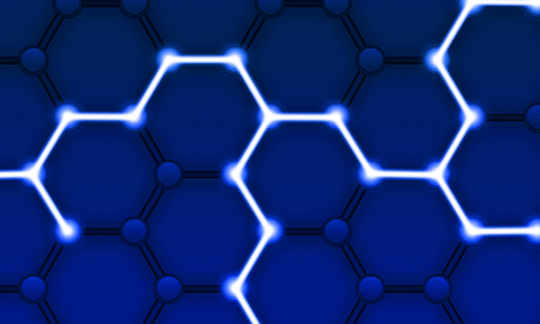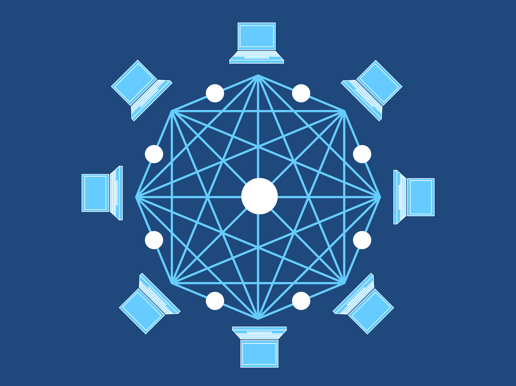by
The DermEngine Team on Mar 28, 2019
Rather than just being associated with ‘Bitcoin’, the popular cryptocurrency, blockchain has the potential to transform how all transactions are completed. By 2025, blockchain will have a projected value of $5.6 B in healthcare alone - an estimate drawing attention from stakeholders across the globe.1
What is it?
Invented in 2008, Bitcoin is one of many applications that uses blockchain technology to facilitate digital currency transactions. In short, blockchain serves as a publicly distributed digital ledger that permanently stores transactional history in “blocks.” Information can also be shared with multiple users on an open network, and is capable of being updated on all users’ accounts simultaneously (given that the users approve its legitimacy). This process, called "distributed consensus," is commonly used by cryptocurrencies because users can publicly verify transactions,2 therefore removing the possibility of double-spending and the need for costly and inefficient third party intervention.3
Experts discovered that blockchain’s traceable network may also be applied to all sorts of data - not just cryptocurrencies. Information such as asset history (houses, equipment), insurance history, employee payrolls, and even international trading could be documented on the blockchain. Although, one problem with this lies in the fact that blockchain’s open-source nature immediately dismisses the idea of storing confidential information.
However, this may evolve over time; recently, Ethereum created a software that adds ‘smart contracts' to the blockchain which lets users encrypt private information, and control who is granted or restricted access to their personal blockchain portfolio.4 But how does all this relate to healthcare?

An underlying issue in healthcare is the lengthy processing time required to register a patient, find an available specialist, offer a thorough consultation, and perform an operation on the select few. Blockchain would provide medical workers access to a decentralized platform that is capable of resolving interdepartmental communication issues by connecting the healthcare ecosystem without the dependency of third party software.
The following sections will touch base on the advantages (in addition to increased connectivity) and disadvantages of implementing blockchain in the health industry today.
Advantages
Using blockchain and the advent of smart contracts, dermatology patients would be able to store their health history and medical records on a private blockchain that is secured with an encrypted key. Whenever the patient is requested to disclose specific medical information, they simply create a temporary key and forward it to their consulting dermatologist who will be given permission to decrypt the relevant information. As a result, direct and secure patient-to-dermatologist communication would allow for uninterrupted exchanges of sensitive information that are required for offering quality care.
Applied to dermatology, blockchain’s shared consensus network would bring more options to patients when selecting a specialist, which could reveal a new care framework that supports quality care. After a consultation or operation with their dermatologist, patients would be expected to verify the consultation that took place on the blockchain ledger where it is permanently stored. Interestingly, a “quarter to one-half of referring physicians do not know whether their patients see the specialist” they were referred to.5
Blockchain solves the dreaded “double-input” problem in health/medicine, and eliminates the possibility of duplicate procedures. Additionally, by referring to the digital ledger’s impervious history, patients could seek (and provide) past consultations performed by dermatologists with the assurance of documented peer consensuses.

Disadvantages
Along with the advantages of blockchain, it also holds some unfavourable features. Firstly, and perhaps a shared opinion among the average tech user, is that blockchain is confusing! There are many people who are familiar with the technology, but lack knowledge of its cryptographic foundation which creates a barrier to nurturing its widespread adoption. The complicated technology promotes uncertainty and skepticism with its capabilities, especially since it is not widely used in professional industries across the globe, including healthcare. It may take some time before blockchain fully supports operations, because potential users will likely need thorough education to understand its transaction process before entrusting it.
Secondly, if blockchain’s principles were easy to grasp and could be implemented today, current systems would require intensive preparation to ensure that pre-existing databases transfer smoothly to the new digital ledgers. Factors included in a system-wide upgrade would require countless hours of programming and research into financial feasibility, software and equipment interoperability, and various safeguard measures. In this respect, each organization looking to remodel their operating systems with blockchain would be required to take full responsibility of back-end programming and designing custom software to cater to their individual operational needs.
Final Thoughts
In health systems, the use of blockchain would streamline processes by promoting connectivity between medical workers using a decentralized model. Additionally, smart contracts’ impressive functionalities enhance this model by implementing robust security and privacy measures to keep patient data safe, and maintain the integrity of medical specialists - but at the cost of confusion and steep implementation requirements. Nonetheless, blockchain is an elaborate technology that holds the power to transform the future of informational transactions everywhere, using its progressive open-source digital ledger.
-The MetaOptima Team
Would you like to stay updated on the latest news of MetaOptima and its intelligent dermatology software, DermEngine? Subscribe to our blog! If you're ready to experience DermEngine's intuitive features firsthand, request your demo today!

Sources:
1-https://medium.com
2-https://j2-capital.com
3-https://www.forbes.com
4-https://www.mdpi.com
5-https://getreferralmd.com







